精算师考试试题 (5)
中国精算师考试考试题目

选择题:在保险精算中,确定保费时需要考虑的主要因素不包括:A. 被保险人的年龄B. 被保险人的性别C. 被保险人的职业D. 被保险人的婚姻状况(正确答案)下列哪项不是精算师在保险公司中的主要职责?A. 产品设计与定价(正确答案)B. 市场营销策略制定C. 准备金评估D. 风险管理在进行寿险精算时,下列哪个公式用于计算纯保费?A. 纯保费= 保险金额× 发生率B. 纯保费= 保险金额/ 发生率C. 纯保费= 保险金额× (1 -发生率)D. 纯保费= 保险金额+ 发生率(正确答案)下列哪项不是影响保险公司偿付能力的主要因素?A. 资本金数额B. 准备金数额C. 保险业务规模D. 公司员工数量(正确答案)在进行非寿险精算时,下列哪个概念用于描述单位时间内发生赔案的频率?A. 赔案发生率(正确答案)B. 平均赔款额C. 纯保费D. 附加保费下列哪项不是精算师在进行财务分析时常用的工具?A. 财务报表B. 敏感性分析C. 场景分析D. 市场调研问卷(正确答案)在进行保险产品设计时,精算师需要考虑的法律法规不包括:A. 《保险法》B. 《公司法》C. 《税收法》D. 《消费者权益保护法》(正确答案)下列哪项不是精算师在风险管理中的主要任务?A. 识别风险B. 量化风险C. 控制风险D. 承担风险(正确答案)在进行保险产品定价时,下列哪个因素通常不会被考虑?A. 预期赔付成本B. 运营成本C. 预期利润D. 市场竞争对手的股价(正确答案)。
2021精算师考试《精算模型》真题模拟及答案(5)

2021精算师考试《精算模型》真题模拟及答案(5)1、如果假设每份保单的索赔次数服从泊松分布,而在一个保单组合中,不同保单的泊松参数服从参数为(α,β)的伽玛分布,已知记录了个体保单在n年内的经验索赔次数,则Bühlmann信度模型的信度因子为()。
(单选题)A. nα/(nα+1)B. n/(n+β)C. nβ/(nβ+1)D. n/(n+αβ)E. n/(n+α+β)试题答案:C2、设死力函数,则=()。
(单选题)A.B.C.D.E.试题答案:D3、计算v x,v x+1和v x+2时,将出现()个不同的u x。
(单选题)A. 12B. 13C. 14D. 15E. 16试题答案:D4、在关于硬币上抛例子中,我们仍取先验均值是1/2。
现把此硬币上抛10次,得到7次正面。
对于较少的上抛次数,我们认为对先验观点的置信度是对试验结果的置信度的两倍。
按照已经得到的试验结果,T的修正“期望值”(即后验均值)是()。
(单选题)A. 0.5661B. 0.5663C. 0.5665D. 0.5667E. 0.5669试题答案:D5、某一群体在出生时男女人数相等,且男性的死亡力为μm(x)=0.09(x≥0),女性的死亡力为μf(x)=0.07(x≥0),则这个人群50岁的死亡概率q50=()。
(单选题)A. 0.0525B. 0.0653C. 0.0726D. 0.0779E. 0.0842试题答案:C6、考虑下述人寿保单:若被保险人在一年内因意外事故死亡,则赔偿5万元;而因非意外事故死亡,则赔偿2.5万元。
设该人群内因意外事故及非意外事故的死亡率分别为0.0005及0.002,即:P{I=1,B=5}=0.0005P{I=1,B=2.5}=0.002其中记X为每个被保险人的实际索赔金额,则E(X)+ (单选题)A. 0.0324B. 0.0474C. 0.1278D. 0.1653E. 0.1728试题答案:D7、某保险公司承保的某风险组合在单位时间内期望的索赔金额是60个单位元,初始盈余为180元。
2020年中国精算师考试试题:(冲刺必看题5)

2020年中国精算师考试试题:(冲刺必看题5)多项选择题1.以下陈述中。
哪几项是错误的?A.保险人对自留额的精度要求不高时,采用相对自留额;B.各类风险同质性较高,只能采用绝对自留额;C.绝对自留额的优点是操作简便、减少成本;D.相对自留额相比于绝对自留额的优点是易于监管;E.保险人缺乏经验时,常采用绝对自留额法。
2.下列哪些命题是准确的?A.NCD制度有助于减少小额索赔发生次数;B.NCD制度在精算上绝对公平;C.NCD制度会导致高折扣组别的保单数增加;D.NCD制度有助于竞争;E.转移概率矩阵是NCD制度的全部内容。
3.关于经验估费法,下列命题中哪几项是准确的?A.最小平方信度方法就是求使信度估计误差平方的期望达到最小的信度因子a值的方法;B.最小平方信度估计与贝叶斯估计是一致的,当贝叶斯估计采用平方损失函数时;C.假设各类风险的风险单位数相等,那么用最小平方信度方法求出的信度因子a具有的形式,其中,n是样本容量,k的分子、分母分别为被估计量的条件方差的期望和条件期望的方差;D.假设先验信息数据为15,最近观察值为20,信度因子a=O.6,那么所求的可信度估计为:0.6×15+0.4×20;E.X服从参数为的指数分布,参数为一随机变量,并设其服从指数为 1的指数分布,则的后险分布也是指数分布。
4.关于准备金的陈述,下列哪几项是准确的?A.逐案估计法没有考虑到IBNR索赔,这是其不足之处;B.链梯法与修正IBNR方法均属于统计方法;C.如果某一年期财产保险的年保费总收入为400万元,假设该保费收入在一年内是服从均匀分布的,则在会计年度末应该计提的未到期责任准备金为200万元;D.假设保费收入在季度内是均匀分布的,已知某财产保险的保费收入情况是:则会计年度末应计提的未到期准备金为210万元;E.在“C”的陈述中,根据我国相关法律,到会计年度末应该计提的未到期责任准备金为240万元。
2020精算师考试《精算模型》真题模拟及答案(5)
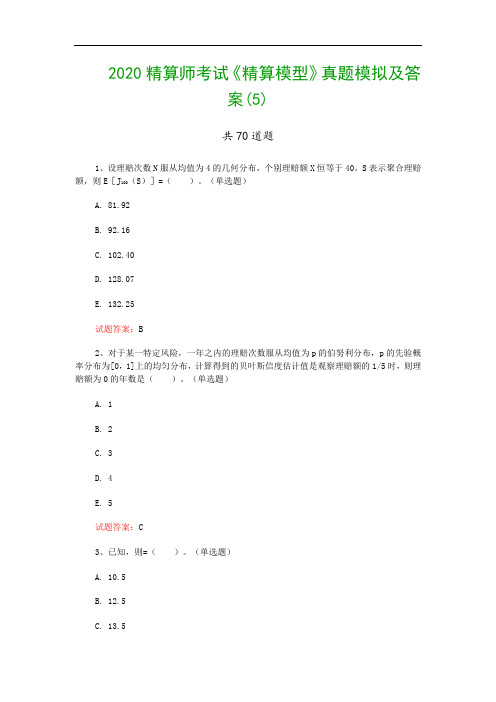
2020精算师考试《精算模型》真题模拟及答案(5)共70道题1、设理赔次数N服从均值为4的几何分布,个别理赔额X恒等于40。
S表示聚合理赔额,则E[J100(S)]=()。
(单选题)A. 81.92B. 92.16C. 102.40D. 128.07E. 132.25试题答案:B2、对于某一特定风险,一年之内的理赔次数服从均值为p的伯努利分布,p的先验概率分布为[0,1]上的均匀分布,计算得到的贝叶斯信度估计值是观察理赔额的1/5时,则理赔额为0的年数是()。
(单选题)A. 1B. 2C. 3D. 4E. 5试题答案:C3、已知,则=()。
(单选题)A. 10.5B. 12.5C. 13.5D. 15.5E. 16.5试题答案:A4、已知。
运用K-J修匀法,求(A+B)-1(u-m)=()。
(单选题)A.B.C.D.E.试题答案:C5、设某险种索赔额为常数,在正态假设下计算信度因子为1/2的期望索赔次数为(),设p=0.90,k=0.05。
(单选题)A. 250B. 260C. 270D. 280E. 290试题答案:C6、用平移伽马分布近似方法估计聚合理赔款分布,已知:x0=0,E(S)=μ,Var(S)=δ2,E[(S-μ)3]=γ3。
则γ=()。
(单选题)A.B.C.D.E.7、已知损失额X服从单参数的Pareto分布,其分布密度函数为:随机抽取5个样本,其中2个样本都超过了25,但具体数额未知,另外3个样本分别为3,6和14。
则参数α的极大似然估计为()。
(单选题)A. 0.1575B. 0.2507C. 0.3750D. 0.4500E. 0.6250试题答案:B8、寿命X是随机变量,则60岁的人的寿命不超过80岁的概率为()。
(单选题)A. (1)(2)B. (1)(3)C. (2)(4)D. (3)(4)E. (4)试题答案:A9、在x岁的样本中,n x=14200,c x=4400个对象预计在岁结束,观察得是在岁之前的c x中的死亡人数,是在(x+1)岁之前剩下的观察人群n x-c x中的死亡人数,假设在区间(x,x+1]上的死亡力为常数,则q x的极大似然估计量为()。
保险精算考试题及答案

保险精算考试题及答案1. 保险精算中,用于计算未来现金流的现值的公式是:A. 未来值 = 现值× (1 + 利率)^期数B. 现值 = 未来值÷ (1 + 利率)^期数C. 未来值 = 现值× (1 - 利率)^期数D. 现值 = 未来值× (1 - 利率)^期数答案:B2. 在非寿险精算中,用于计算纯保费的公式是:A. 纯保费 = 预期损失 + 预期费用B. 纯保费 = 预期损失 - 预期费用C. 纯保费 = 预期损失× 预期费用D. 纯保费 = 预期损失÷ 预期费用答案:A3. 以下哪项是寿险精算中的生命表的主要组成部分?A. 死亡率表B. 疾病率表C. 残疾率表D. 以上都是答案:A4. 寿险精算中,计算年金现值的公式是:A. 年金现值 = 年金支付额× 利率× (1 - 1/(1 + 利率)^期数)B. 年金现值 = 年金支付额÷ 利率× (1 - 1/(1 + 利率)^期数)C. 年金现值 = 年金支付额× 利率÷ (1 - 1/(1 + 利率)^期数)D. 年金现值 = 年金支付额÷ 利率÷ (1 - 1/(1 + 利率)^期数) 答案:A5. 保险精算中,用于评估保险公司财务稳定性的指标是:A. 偿付能力比率B. 资产负债比率C. 投资回报率D. 以上都是答案:A6. 在精算评估中,用于计算保单持有人未来利益的现值的贴现率是:A. 预定利率B. 市场利率C. 法定利率D. 以上都不是答案:A7. 以下哪项是精算师在评估寿险保单的死亡率风险时常用的方法?A. 蒙特卡洛模拟B. 敏感性分析C. 精算表分析D. 以上都是答案:C8. 保险精算中,用于计算保单持有人未来利益的现值的公式是:A. 未来利益现值 = 未来利益× 利率× (1 - 1/(1 + 利率)^期数)B. 未来利益现值 = 未来利益÷ 利率× (1 - 1/(1 + 利率)^期数)C. 未来利益现值 = 未来利益× 利率÷ (1 - 1/(1 + 利率)^期数)D. 未来利益现值 = 未来利益÷ 利率÷ (1 - 1/(1 + 利率)^期数) 答案:B9. 在保险精算中,用于计算保单的准备金的公式是:A. 准备金 = 未来利益现值 - 已收保费B. 准备金 = 未来利益现值 + 已收保费C. 准备金 = 未来利益现值× 已收保费D. 准备金 = 未来利益现值÷ 已收保费答案:A10. 以下哪项是保险精算中用于评估保单持有人未来利益的不确定性的方法?A. 精算评估B. 风险评估C. 敏感性分析D. 以上都是答案:C。
精算师资格考试真题
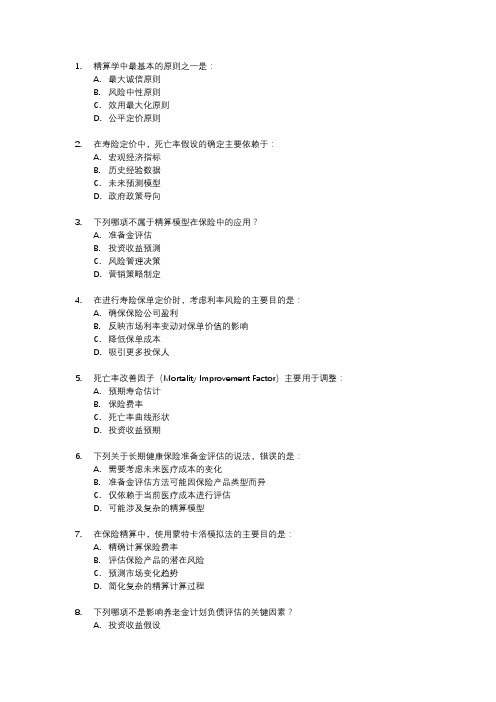
1.精算学中最基本的原则之一是:A.最大诚信原则B.风险中性原则C.效用最大化原则D.公平定价原则2.在寿险定价中,死亡率假设的确定主要依赖于:A.宏观经济指标B.历史经验数据C.未来预测模型D.政府政策导向3.下列哪项不属于精算模型在保险中的应用?A.准备金评估B.投资收益预测C.风险管理决策D.营销策略制定4.在进行寿险保单定价时,考虑利率风险的主要目的是:A.确保保险公司盈利B.反映市场利率变动对保单价值的影响C.降低保单成本D.吸引更多投保人5.死亡率改善因子(Mortality Improvement Factor)主要用于调整:A.预期寿命估计B.保险费率C.死亡率曲线形状D.投资收益预期6.下列关于长期健康保险准备金评估的说法,错误的是:A.需要考虑未来医疗成本的变化B.准备金评估方法可能因保险产品类型而异C.仅依赖于当前医疗成本进行评估D.可能涉及复杂的精算模型7.在保险精算中,使用蒙特卡洛模拟法的主要目的是:A.精确计算保险费率B.评估保险产品的潜在风险C.预测市场变化趋势D.简化复杂的精算计算过程8.下列哪项不是影响养老金计划负债评估的关键因素?A.投资收益假设B.死亡率假设C.税收政策变化D.产品设计细节9.在进行再保险安排时,精算师需要评估的主要风险包括:A.市场风险、信用风险、操作风险B.利率风险、汇率风险、政治风险C.巨灾风险、长尾风险、集中度风险D.流动性风险、技术风险、法律风险10.精算师在保险产品设计阶段,主要关注的是:A.如何提高产品知名度B.如何降低营销成本C.如何确保产品定价的公平性和合理性D.如何快速响应市场变化。
2021精算师考试《精算管理》真题模拟及答案(5)
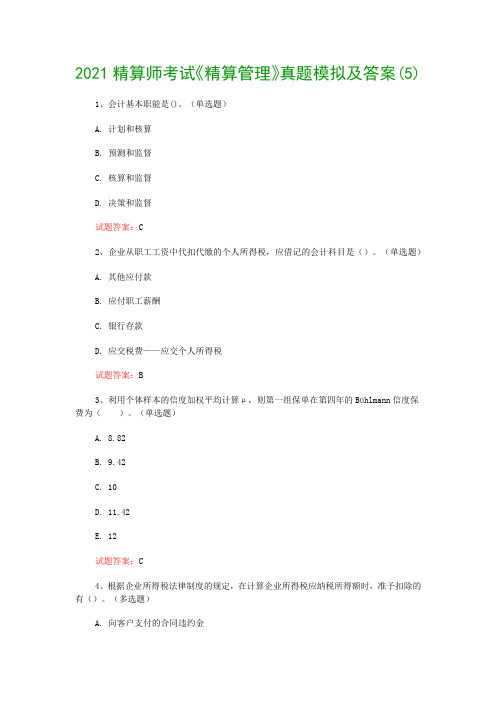
2021精算师考试《精算管理》真题模拟及答案(5)1、会计基本职能是()。
(单选题)A. 计划和核算B. 预测和监督C. 核算和监督D. 决策和监督试题答案:C2、企业从职工工资中代扣代缴的个人所得税,应借记的会计科目是()。
(单选题)A. 其他应付款B. 应付职工薪酬C. 银行存款D. 应交税费——应交个人所得税试题答案:B3、利用个体样本的信度加权平均计算μ,则第一组保单在第四年的Bühlmann信度保费为()。
(单选题)A. 8.82B. 9.42C. 10D. 11.42E. 12试题答案:C4、根据企业所得税法律制度的规定,在计算企业所得税应纳税所得额时,准予扣除的有()。
(多选题)A. 向客户支付的合同违约金B. 向税务机关支付的税收滞纳金C. 向银行支付的逾期借款利息D. 向公安部门缴纳的交通违章罚款试题答案:A,C5、下列各项中,可以成为法律关系客体的有()。
(多选题)A. 自然人B. 自然物C. 人造物D. 道德产品试题答案:B,C,D6、(1)若样本的生存分布为区间(0,15]上的均匀分布,则Var[So(6)]=____;(2)若没有均匀分布的假设,则估计值Var[So(6)]=____。
()(单选题)A. 0.03,0.03125B. 0.03,0.045C. 0.03125,0.03D. 0.03125,0.045E. 0.045,0.03125试题答案:A7、根据增值税法律制度的规定,下列行为中,属于视同销售服务或无形资产的有()。
(多选题)A. 单位向客户无偿转让专利技术使用权B. 单位向客户无偿提供运输服务C. 单位向本单位员工无偿提供搬家服务D. 单位向本单位员工无偿提供房屋装饰服务试题答案:A,B8、设S1服从复合泊松分布,泊松变量的期望为10,个体索赔额的分布为f X(1)=0.80,f X(2)=0.20,S2也服从复合泊松分布,泊松变量的期望为20,个体索赔额的分布为f Y(1)=0.70,f Y(2)=0.30,已知S1和S2相互独立,设S=S1+S2,则P(S=2)为()。
中国准精算师考试A5-试卷
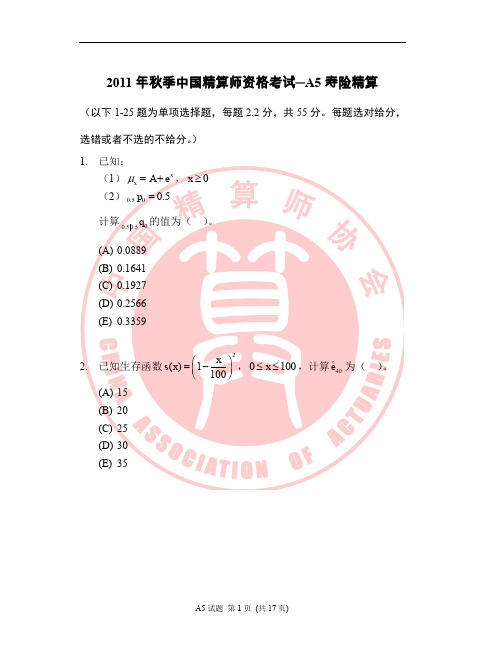
) 。
对当前处于状态 0 的老年人, 计算未来的期望开支的总额为 ( (A) 28454 (B) 28954 (C) 29332 (D) 29702 (E) 30454
18. 已知 ( x) 的生存函数为
x , 1 s( x) 110 0, (0 x 110) ( x 110)
假设 (45) 与 (50) 的未来生存时间相互独立,计算状态 (45 : 50) 的完全平 均余命为( (A) 18.78 (B) 19.97 (C) 20.77 (D) 21.72 (E) 22.34 19. T ( x) 、 T ( y) 为未来寿命的随机变量,已知: (1) Pr(T ( x) T ( y)) 0.4 ( 2 )当 T ( x) T ( y) 时,有联合密度函数 fT ( x ),T ( y ) (t , s) 0.0005 ,
A5 试题 第 3 页 (共 17 页)
9. 已知: (1) nVx 0.08 (2) Px 0.024
1 0.2 (3) Px:n
计算 Px1:n 的值为( (A) 0.008 (B) 0.009 (C) 0.010 (D) 0.011 (E) 0.012 10. 已知:
) 。
(1) 1000 tV ( A x ) 100 (2) 1000P ( A x ) 11 (3) 0.03 计算 ax t 的值为( (A) 18.96 (B) 21.95 (C) 23.25 (D) 24.95 (E) 26.12 )
A5 试题 第 4 页 (共 17 页)
金融精算考试题及答案大全

金融精算考试题及答案大全一、单项选择题(每题2分,共40分)1. 精算学中,以下哪项是寿险精算中的生命表?A. 经验生命表B. 理论生命表C. 人口生命表D. 经济生命表答案:A2. 以下哪个不是精算师在进行风险评估时考虑的因素?A. 死亡率B. 利率C. 通货膨胀率D. 法律风险答案:D3. 在寿险中,年金的计算不包括以下哪项?A. 即期年金B. 递延年金C. 等额年金D. 非等额年金答案:D4. 精算学中,以下哪项是用于评估保险公司偿付能力的指标?A. 偿付能力比率B. 资产负债比率C. 投资回报率D. 利润率5. 以下哪个不是精算师在产品设计时需要考虑的因素?A. 保险责任B. 定价策略C. 投资策略D. 市场趋势答案:C6. 在精算学中,以下哪项是用于评估保险合同财务状况的指标?A. 净现值B. 内部收益率C. 偿付能力充足率D. 资产负债匹配答案:A7. 以下哪个不是精算师在进行资产负债管理时需要考虑的因素?A. 资产配置B. 负债期限C. 利率风险D. 市场风险答案:D8. 在精算学中,以下哪项是用于评估保险合同盈利能力的指标?A. 利润测试B. 损失率C. 费用率D. 赔付率答案:A9. 以下哪个不是精算师在进行寿险定价时需要考虑的因素?B. 利率C. 费用率D. 投资回报率答案:D10. 在精算学中,以下哪项是用于评估保险公司财务稳定性的指标?A. 资本充足率B. 偿付能力比率C. 资产负债比率D. 利润率答案:B11. 以下哪个不是精算师在进行健康保险定价时需要考虑的因素?A. 疾病发生率B. 医疗费用C. 死亡率D. 投资回报率答案:D12. 在精算学中,以下哪项是用于评估保险合同风险的指标?A. 风险调整资本B. 偿付能力充足率C. 资产负债匹配D. 利润率答案:A13. 以下哪个不是精算师在进行非寿险定价时需要考虑的因素?A. 损失频率B. 损失严重度C. 费用率D. 投资回报率答案:D14. 在精算学中,以下哪项是用于评估保险公司盈利能力的指标?A. 净现值B. 内部收益率C. 利润率D. 资产负债比率答案:C15. 以下哪个不是精算师在进行再保险定价时需要考虑的因素?A. 再保险合同条款B. 再保险市场状况C. 再保险费用D. 投资回报率答案:D16. 在精算学中,以下哪项是用于评估保险合同公平性的指标?A. 保费充足率B. 偿付能力充足率C. 资产负债匹配D. 利润率答案:A17. 以下哪个不是精算师在进行年金定价时需要考虑的因素?A. 年金类型B. 利率C. 死亡率D. 投资回报率答案:D18. 在精算学中,以下哪项是用于评估保险合同持续性的指标?A. 持续率B. 损失率C. 费用率D. 赔付率答案:A19. 以下哪个不是精算师在进行团体保险定价时需要考虑的因素?A. 团体规模B. 团体健康状况C. 死亡率D. 投资回报率答案:D20. 在精算学中,以下哪项是用于评估保险公司流动性的指标?A. 流动比率B. 偿付能力比率C. 资产负债比率D. 利润率答案:A二、多项选择题(每题3分,共30分。
中国精算师考试真题及答案

选择题:
在精算学中,用于评估未来现金流现值的方法是:
A. 历史成本法
B. 现值法(正确答案)
C. 市场比较法
D. 直线摊销法
下列哪项不是精算师在保险公司中的主要职责?
A. 产品定价
B. 风险管理
C. 市场营销策划(正确答案)
D. 准备金评估
在寿险精算中,计算纯保费时通常不考虑以下哪个因素?
A. 预定利率
B. 预定死亡率
C. 预定费用率
D. 预定投资回报率(正确答案)
关于精算控制循环,以下哪个步骤不是其核心环节?
A. 识别风险
B. 量化风险(正确答案)
C. 控制风险
D. 评估风险控制效果
在进行保险产品利润测试时,以下哪项不是必须考虑的因素?
A. 预期赔付率
B. 预期费用率
C. 预期投资收益率
D. 预期市场占有率(正确答案)
下列哪个公式不是用于计算寿险责任准备金的?
A. 未来法
B. 过去法
C. 现在法(正确答案)
D. 平衡法
在非寿险精算中,以下哪个概念用于描述在一定时期内,保险公司为履行未到期责任而提取的准备金?
A. 未决赔款准备金
B. 未到期责任准备金(正确答案)
C. 总准备金
D. 意外准备金
关于精算报告,以下哪个陈述是不正确的?
A. 精算报告应包含所有重要假设和参数
B. 精算报告应基于合理的预测和估计
C. 精算报告无需经过审核即可直接发布(正确答案)
D. 精算报告应清晰、准确地传达精算分析的结果
在进行保险产品定价时,以下哪项不是精算师需要考虑的成本因素?
A. 赔付成本
B. 获取成本
C. 运营成本
D. 广告成本(正确答案)。
中国精算师考试试题及答案(五).doc
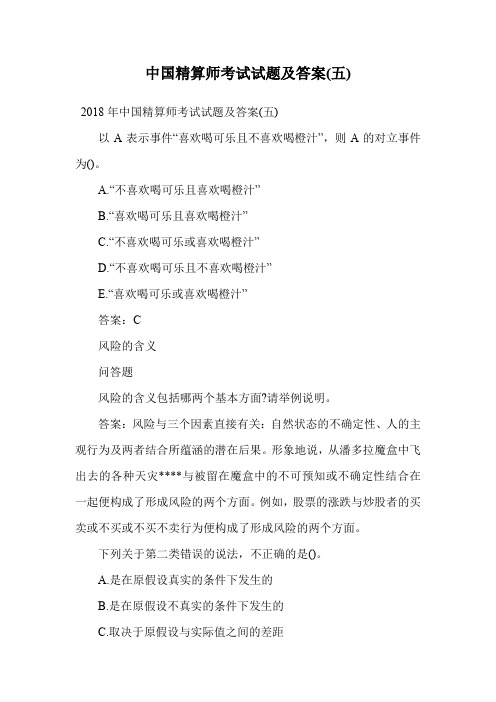
中国精算师考试试题及答案(五)2018年中国精算师考试试题及答案(五)以A表示事件“喜欢喝可乐且不喜欢喝橙汁”,则A的对立事件为()。
A.“不喜欢喝可乐且喜欢喝橙汁”B.“喜欢喝可乐且喜欢喝橙汁”C.“不喜欢喝可乐或喜欢喝橙汁”D.“不喜欢喝可乐且不喜欢喝橙汁”E.“喜欢喝可乐或喜欢喝橙汁”答案:C风险的含义问答题风险的含义包括哪两个基本方面?请举例说明。
答案:风险与三个因素直接有关:自然状态的不确定性、人的主观行为及两者结合所蕴涵的潜在后果。
形象地说,从潘多拉魔盒中飞出去的各种天灾****与被留在魔盒中的不可预知或不确定性结合在一起便构成了形成风险的两个方面。
例如,股票的涨跌与炒股者的买卖或不买或不买不卖行为便构成了形成风险的两个方面。
下列关于第二类错误的说法,不正确的是()。
A.是在原假设真实的条件下发生的B.是在原假设不真实的条件下发生的C.取决于原假设与实际值之间的差距D.原假设与实际值之间的差距越大,犯第二类错误的可能性越小E.原假设与实际值之间的差距越小,犯第二类错误的可能性越大正确答案:A答案解析:第二类错误是原假设不成立,我们却错误地接受它;它取决于原假设与实际值之间的差距;原假设与实际值之间的差距越大,犯第二类错误的可能性越小,原假设与实际值之间的差距越小,犯第二类错误的可能性越大设X,Y为两个相互独立的随机变量,P(X≤1)=0.5,P(Y≤1)=0.4,Z=max{X,Y},则P(Z≤1)=()。
A.0.1B.0.2C.0.4D.0.5E.0.9正确答案:B答案解析:P(Z≤1)=P(max{X,Y}≤1)=P(X≤1,Y≤1)=P(X≤1)P(Y≤1)=0.5×0.4=0.2精算师。
2021精算师考试《金融数学》真题模拟及答案(5)

2021精算师考试《金融数学》真题模拟及答案(5)1、在第n年末付款n,第2n年末付款2n,第mn年末付款mn。
则按等时间法确定的t 的近似值为()。
(单选题)A.B.C.D.E.试题答案:C2、一债券,面值700,期限5年,年名义息票率10%(每半年支付一次),购买价670.60,期满赎回价的现值为372.05,则该债券的期满赎回价为()。
[样题](单选题)A. 450B. 500C. 599D. 606E. 1000试题答案:B3、已知:1+=(1.08+0.005t)1+0.01y,1≤t≤5,0≤y≤10,t,y为整数,若在第6年初投资1个单位,期限3年,计算该投资的年利率为()。
(单选题)A. 9.16%B. 9.36%C. 9.56%D. 9.76%E. 9.96%试题答案:C4、考虑一资产组合,期望收益率为12%,标准差为18%。
国库券的无风险收益率为7%。
投资者的效用函数为:U=E(r)-0.5Aσ2,要使投资者与国库券相比更偏好风险资产组合,风险厌恶系数应满足A<()。
(单选题)A. 3.04B. 3.05C. 3.07D. 3.09E. 3.12试题答案:D5、下列5项中,对应利息强度最大的是()。
(1)i=0.12;(2)d=0.12;(3)i(4)=0.12;(4)d(4)=0.12;(5)d(6)=0.12。
(单选题)A. (1)B. (2)C. (3)D. (4)E. (5)试题答案:B6、甲在一基金中投资,年利率为i,首年末,甲从基金中提出当年所得利息的1.625;第2年末,甲从基金中提出当年所得利息的2×1.625,…。
依此类推,直到第16年末,甲从基金中提出当年所得利息的16×1.625,基金正好全部取完。
则利息率i=()。
(单选题)A. 2%B. 3%C. 4%D. 5%E. 6%试题答案:C7、保险需求的费率弹性是指由于保险费率变动而引起的保险需求量的变动。
保险精算师招聘笔试题与参考答案(某世界500强集团)2025年
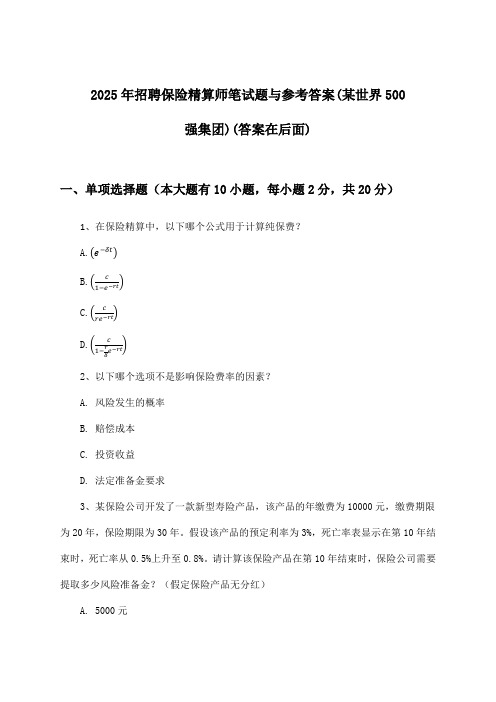
2025年招聘保险精算师笔试题与参考答案(某世界500强集团)(答案在后面)一、单项选择题(本大题有10小题,每小题2分,共20分)1、在保险精算中,以下哪个公式用于计算纯保费?A.(e −δt )B.(c 1−e −rt )C.(c re −rt )D.(c 1−r δe −rt )2、以下哪个选项不是影响保险费率的因素?A. 风险发生的概率B. 赔偿成本C. 投资收益D. 法定准备金要求3、某保险公司开发了一款新型寿险产品,该产品的年缴费为10000元,缴费期限为20年,保险期限为30年。
假设该产品的预定利率为3%,死亡率表显示在第10年结束时,死亡率从0.5%上升至0.8%。
请计算该保险产品在第10年结束时,保险公司需要提取多少风险准备金?(假定保险产品无分红)A. 5000元B. 8000元C. 10000元D. 12000元4、某保险公司计划推出一款定期寿险产品,产品期限为10年,保险金额为100万元。
根据死亡率表,第一年的死亡率估计为1%,第二年为1.2%,以此类推,直到第十年估计死亡率为2%。
假设该产品的预定利率为3%,年缴费为10000元,请计算该保险产品在第一年结束时,保险公司需要提取多少风险准备金?(假定保险产品无分红)A. 10000元B. 8000元C. 5000元D. 2000元5、在保险精算中,用于评估长期寿险保单未来现金流的贴现率通常基于:A. 银行的储蓄利率B. 无风险利率加上一定的风险溢价C. 股票市场的平均回报率D. 消费者物价指数(CPI)的增长率6、以下哪项是衡量保险公司偿付能力的重要指标?A. 净利润率B. 资产负债率C. 综合偿付能力充足率D. 市场份额7、以下哪个选项不属于保险精算师在工作中需要考虑的风险因素?A. 投资风险B. 利率风险C. 流动性风险D. 税收风险8、以下哪个公式描述了纯保费的计算?A. 纯保费 = 风险保费 + 预期利润B. 纯保费 = 风险保费 + 费用保费C. 纯保费 = 风险保费 / 预期赔付率D. 纯保费 = 风险保费 * 预期赔付率9、在保险精算中,用于评估长期寿险保单未来现金流现值的常用方法是:A、净现值法B、内部收益率法C、等价现值法D、现值贴现法 10、以下哪项不属于保险精算师在进行风险评估时需要考虑的因素?A、投保人的年龄和性别B、保险产品的类型与期限C、当前市场的股票价格D、被保险人的健康状况与职业二、多项选择题(本大题有10小题,每小题4分,共40分)1、以下哪些是保险精算师在制定保险费率时需要考虑的因素?()A、历史赔付数据B、市场利率C、预期通货膨胀率D、公司成本E、政策法规2、以下关于生命表的说法,正确的是哪些?()A、生命表是记录特定年龄人群生存概率的工具B、生命表可以用来计算保险产品的保费和责任准备金C、生命表的数据通常是基于特定地区和特定时间点的统计数据D、生命表的数据是静态的,不会随时间变化E、生命表可以用来评估保险公司的财务状况3、以下哪些因素通常会影响保险产品的定价?A. 死亡率或发病率B. 投资收益率C. 市场竞争情况D. 政策法规变化4、在保险精算中,关于准备金评估,以下哪些说法是正确的?A. 准备金是用于支付未来保险责任的资金储备B. 准备金评估仅依赖于过去的经验数据C. 准备金评估需要考虑未来可能的赔付情况D. 准备金水平的高低直接影响保险公司的偿付能力5、以下哪些因素会影响保险精算师在评估风险时对保费率的设定?A. 预期赔付成本B. 预期死亡率C. 利率水平D. 投保人年龄E. 通货膨胀率6、在制定保险产品定价策略时,以下哪些方法是保险精算师常用的?A. 成本法B. 市场比较法C. 经验法D. 投资收益法E. 需求估计法7、以下哪些因素通常会影响保险产品的定价?A、死亡率或发病率B、保险公司的运营成本C、市场供需关系D、投保人的年龄和性别8、在保险精算中,以下哪些方法或工具常用于评估风险?A、生存模型B、损失分布分析C、蒙特卡洛模拟D、敏感性分析9、以下哪些是保险精算师在评估风险时需要考虑的因素?()A. 保险公司的资本充足率B. 投保人的年龄和健康状况C. 市场利率的变化D. 法规和政策的变化E. 自然灾害的发生频率 10、以下哪些方法可以用于评估保险公司的偿付能力?()A. 标准化比率测试B. 风险资本模型C. 现金流量测试D. 精算假设敏感性分析E. 市场风险价值(VaR)三、判断题(本大题有10小题,每小题2分,共20分)1、保险精算师在评估保险产品定价时,应仅考虑历史赔付数据,而不需考虑市场利率的变化。
准精算师考试(a5寿险精算)考试题库

准精算师考试(a5寿险精算)考试题库一、基础概念1、寿险合同中,通常提到的“全残”是指哪种情况?A. 轻微残疾B. 永久残疾C. 完全残疾D. 部分残疾2、在寿险精算中,“生存函数”主要描述的是?A. 死亡的可能性B. 生存的可能性C. 死亡的平均年龄D. 死亡的速度3、在寿险合同中,通常提到的“不可抗辩条款”是指什么?A. 在被保险人提出质疑的期限后,保险公司不得以任何理由拒绝赔付B. 在被保险人提出质疑的期限后,保险公司可以免除保险责任C. 在被保险人提出质疑的期限内,保险公司可以免除保险责任D. 在被保险人提出质疑的期限内,保险公司不得以任何理由拒绝赔付二、生存模型1、常见的男性生命表主要参考的是哪个年龄段的男性死亡率?A. 0-1岁B. 1-10岁C. 10-50岁D. 50-100岁2、在寿险精算中,“生命表”主要被用于计算哪种类型的保险?A. 人寿保险B. 财产保险C. 健康保险D. 车险3、“均匀死亡力”假设是指什么?A. 假设死亡率在整个生命过程中保持不变B. 假设死亡率随着年龄的增加而线性增加C. 假设死亡率在年轻时较高,老年时较低D. 假设死亡率在老年时较高,年轻时较低三、风险模型与费率计算1、在寿险精算中,“利率”对保险费率的影响主要体现在哪些方面?A. 影响保险期限B. 影响死亡赔偿金额C. 影响保费金额和保险期限的关系D. 影响保单持有人退保的金额2、“风险保费”是指什么?A. 与特定风险相关的保费,通常基于历史数据和统计模型计算得出B. 与所有风险相关的保费,不考虑个体差异C. 根据被保险人的年龄和性别确定的保费D. 根据被保险人的健康状况确定的保费四、再保险与风险管理1、寿险公司通过再保险转移风险,主要是为了达到什么目的?A. 提高保费收入B. 降低赔付风险C. 扩大保险业务范围D. 提高公司的市场占有率2、在寿险精算中,用于描述个体风险差异的常用参数是?A. 平均死亡率B. 标准差C. 变异系数D. 偏态系数3、在寿险合同中,通常提到的“保险利益原则”是指什么?A. 被保险人必须从保险合同中获得实际利益B. 只有被保险人对其所处危险具有保险利益C. 投保人不能为自己投保,以防止道德风险D. 保险人必须为被保险人的所有家庭成员提供保障。
精算师职业考试

选择题下列哪项不属于精算师在寿险公司的主要职责?A. 产品定价B. 客户服务C. 准备金评估D. 风险管理死亡率表中,假设使用的是哪种类型的概率分布来描述人群的死亡情况?A. 正态分布B. 泊松分布C. 二项分布D. 生存分析中的经验分布在精算模型中,对于随机变量X的期望值E(X)与方差Var(X),若已知E(X)=10,Var(X)=4,则E(X^2)为多少?A. 100B. 104C. 108D. 116以下哪项不属于常用的准备金评估方法?A. 净保费准备金法B. 已发生及已报案准备金法C. 未决赔款准备金法D. 市场价值评估法利率风险对于长期寿险产品定价的影响主要体现在哪一方面?A. 降低产品成本B. 增加资本要求C. 改变保险责任的赔付模式D. 影响保险费的计算及保单现金价值下列哪个概念在养老金计划中最为关键?A. 投资收益率B. 替代率C. 死亡率D. 费用率简答题简述精算师在保险公司进行产品定价时需要考虑的主要因素。
解释“净保费”与“毛保费”之间的区别,并说明其在保险产品定价中的作用。
论述准备金评估对于保险公司经营稳健性的重要性。
简要介绍“现金流测试”在寿险产品定价中的应用及其目的。
分析利率变动对保险公司投资策略和风险管理的影响。
描述在设计一个养老保险计划时,需要考虑的养老金支付方式及其各自特点。
填空题精算学中,用____来衡量一个随机变量波动程度的大小。
在死亡率表编制过程中,通常需要去除的异常数据包括新生儿死亡率和____死亡率。
在保险产品中,通常使用____法来计算长期保单的未来价值。
精算师在评估未决赔款准备金时,常用的技术方法包括链梯法、B-F法和____法。
在设计保险合同时,确定保险费率时需考虑成本、利润、____以及预期损失率等因素。
精算师考试试题 (5)
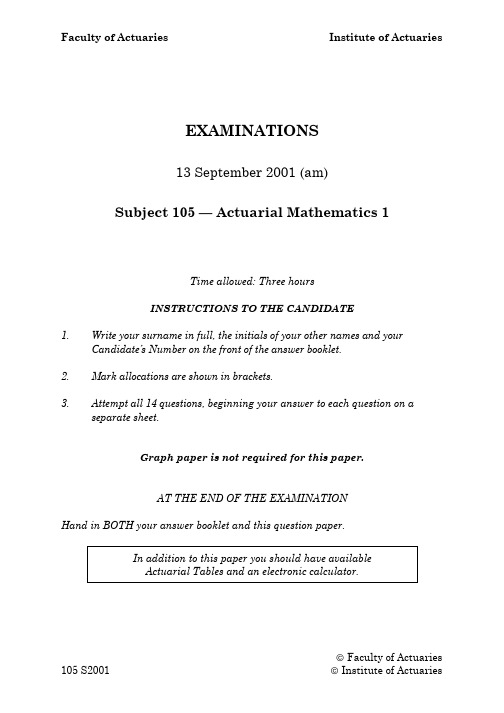
Faculty of Actuaries Institute of ActuariesEXAMINATIONS13 September 2001 (am)Subject 105 — Actuarial Mathematics 1Time allowed: Three hoursINSTRUCTIONS TO THE CANDIDATE1.Write your surname in full, the initials of your other names and yourCandidate’s Number on the front of the answer booklet.2.Mark allocations are shown in brackets.3.Attempt all 14 questions, beginning your answer to each question on aseparate sheet.Graph paper is not required for this paper.AT THE END OF THE EXAMINATIONHand in BOTH your answer booklet and this question paper.In addition to this paper you should have availableActuarial Tables and an electronic calculator.ã Faculty of Actuaries1Under the Manchester Unity model of sickness, you are given the following values:=5xs1 0=0.9 t xp dtòCalculate the value ofxz. [2]2Give a formula for21(2003)P in terms of20(2002)P, based on the component method of population projection. ()xP n denotes the population aged x last birthday at mid-year n.State all the assumptions that you make and define carefully all the symbols that you use. [3]3 A life insurance company issues a policy under which sickness benefit of £100 perweek is payable during all periods of sickness. There is a waiting period of 1 year under the policy.You have been asked to calculate the premium for a life aged exactly 30, who isin good health, using the Manchester Unity model of sickness.Describe how you would allow for the waiting period in your calculation, giving a reason for your choice of method. [3]4An employer recruits lives aged exactly 20, all of whom are healthy whenrecruited. On entry, the lives join a scheme that pays a lump sum of £50,000immediately on death, with an additional £25,000 if the deceased was sick at the time of death.The mortality and sickness of the scheme members are described by the following multiple-state model, in which the forces of transition depend on age only.All surviving members retire at age 65 and leave the scheme regardless of their state of health.,ab x t p is defined as the probability that a life who is in state a at age x (a = H, S, D )is in state b at age x + t (0 and ,,)t b H S D ≥=.Write down an integral expression for the expected present value, at force of interest δ, of the death benefit in respect of a single new recruit. [3]5 A pension scheme provides a pension of 1/60 of career average salary in respect ofeach full year of service, on age retirement between the ages of 60 and 65. A proportionate amount is provided in respect of an incomplete year of service.At the valuation date of the scheme, a new member aged exactly 40 has an annual rate of salary of £40,000.Calculate the expected present value of the future service pension on age retirement in respect of this member, using the Pension Fund Tables in the Formulae and Tables for Actuarial Examinations. [3]6 A life insurance company issues a special annuity contract to a male life agedexactly 70 and a female life aged exactly 60.Under the contract, an annuity of £10,000 per annum is payable monthly to thefemale life, provided that she survives at least 10 years longer than the male life.The annuity commences on the monthly policy anniversary next following thetenth anniversary of the death of the male life and is payable for the balance ofthe female’s lifetime.Calculate the single premium required for the contract.Basis:Mortality:a(55) Ultimate, males or females as appropriateInterest:8% per annumExpenses:none [4]7The staff of a company are subject to two modes of decrement, death and withdrawal from employment.Decrements due to death take place uniformly over the year of age in theassociated single-decrement table: 50% of the decrements due to withdrawaloccur uniformly over the year of age and the balance occurs at the end of the year of age, in the associated single-decrement table.You are given that the independent rate of mortality is 0.001 per year of age and the independent rate of withdrawal is 0.1 per year of age.Calculate the probability that a new employee aged exactly 20 will die as anemployee at age 21 last birthday. [4]8The following data are available from a life insurance company relating to the mortality experience of its temporary assurance policyholders.,x dθThe number of deaths over the period 1 January 1998 to 30 June 2001, aged x nearest birthday at entry and having duration d at the policyanniversary next following the date of death.,()y eP n The number of policyholders with policies in force at time n, aged y nearest birthday at entry and having curtate duration e at time n, wheren = 1.1.1998, 30.6.1998, 30.6.2000 and 30.6.2001.Develop formulae for the calculation of the crude central select rates of mortality corresponding to the,x dθ deaths and derive the age and duration to which these rates apply. State all the assumptions that you make.[6]9(i)State the conditions necessary for gross premium retrospective and prospective reserves to be equal. [3] (ii)Demonstrate the equality of gross premium retrospective and prospective reserves for a whole life policy, given the conditions necessary for equality.[4][Total 7]10 A life insurance company issues a special term assurance policy to two lives agedexactly 50 at the issue date, in return for the payment of a single premium. The following benefits are payable under the contract:(i)In the event of either of the lives dying within 10 years, a sum assured of£100,000 is payable immediately on this death.(ii)In the event of the second death within 10 years, a further sum assured of £200,000 is payable immediately on the second death.Calculate the single premium.Basis:Mortality:A1967–70 UltimateInterest:4% per annumExpenses:None [8]11 A life insurance company sells term assurance policies with terms of either 10 or20 years.As an actuary in the life office, you have been asked to carry out the first review of the mortality experience of these policies. The following table shows thestatistical summary of the mortality investigation. In all cases, the central rates of mortality are expressed as rates per 1,000 lives.All policies10-year policies20-year policiesAge Numberin forceCentralmortalityrateNumberin forceCentralmortalityrateNumberin forceCentralmortalityrate–246,991 1.086,0130.86978 2.12 25–446,462 2.055,438 1.741,024 3.68 45–645,81513.264,94211.5587322.94 65–3,05175.702,57071.5348197.70 Total22,31918,9633,356(i)Calculate the directly standardised mortality rate and the standardisedmortality ratio separately in respect of the 10-year and 20-year policies.In each case, use the “all policies” population as the standard population.[6](ii)You have been asked to recommend which of these two summary mortality measures should be monitored on a regular basis.Give your recommendation, explaining the reasons for your choice. [3][Total 9]12 A life insurance company offers an option on its 10-year without profit termassurance policies to effect a whole life without profits policy, at the expiry of the 10-year term, for the then existing sum assured, without evidence of health.Premiums under the whole life policy are payable annually in advance for thewhole of life, or until earlier death.(i)Describe the conventional method of pricing the mortality option, statingclearly the data and assumptions required. Formulae are not required.[3](ii) A policyholder aged exactly 30 wishes to effect a 10-year without profits term assurance policy, for a sum assured of £100,000.Calculate the additional single premium, payable at the outset, for theoption, using the conventional method.The following basis is used to calculate the basic premiums for the termassurance policies.Basis:Mortality:A1967–70 SelectInterest:6% per annumExpenses:none [4](iii)Describe how you would calculate the option single premium for the policy described in part (ii) above using the North American method, statingclearly what additional data you would require and what assumptions youwould make. [4](iv)State, with reasons, whether it would be preferable to use theconventional method or the North American method for pricing themortality option under the policy described in part (ii) above. [3][Total 14]13(i)On 1 September 1996, a life aged exactly 50 purchased a deferred annuity policy, under which yearly benefit payments are to be made. The firstpayment, being £10,000, is to be made at age 60 exact if he is then alive.The payments will continue yearly during his lifetime, increasing by1.923% per annum compound.Premiums under the policy are payable annually in advance for 10 yearsor until earlier death.If death occurs before age 60, the total premiums paid under the policy,accumulated to the end of the year of death at a rate of interest of 1.923%per annum compound, are payable at the end of the year of death.Calculate the annual premium.Basis:Mortality: before age 60:A1967–70 Ultimateafter age 60:a(55) Males UltimateInterest:6% per annumExpenses: initial:10% of the initial premium, incurredat the outsetrenewal:5% of each of the second andsubsequent premiums, payable at thetime of premium paymentclaim:£100, incurred at the time of paymentof the death benefit[9](ii)On 1 September 2001, immediately before payment of the premium then due, the policyholder requests that the policy be altered so that there is nobenefit payable on death and the rate of increase of the annuity inpayment is to be altered. The premium under the policy is to remainunaltered as is the amount of the initial annuity payment.The life insurance company calculates the revised terms of the policy byequating gross premium prospective reserves immediately before andafter the alteration, calculated on the original pricing basis, allowing foran expense of alteration of £100.Calculate the revised rate of increase in payment of the annuity. [7][Total 16]14 A life insurance company issues a 3-year unit-linked endowment assurancecontract to a male life aged exactly 60 under which level annual premiums of£5,000 are payable in advance throughout the term of the policy or until earlier death. 102% of each year’s premium is invested in units at the offer price.The premium in the first year is used to buy capital units, with subsequent years’premiums being used to buy accumulation units. There is a bid-offer spread in unit values, with the bid price being 95% of the offer price.The annual management charges are 5% on capital units and 1% on accumulation units. Management charges are deducted at the end of each year,before death, surrender or maturity benefits are paid.On the death of the policyholder during the term of the policy, there is a benefit payable at the end of the year of death of £12,000 or the bid value of the units allocated to the policy, if greater. On maturity, the full bid value of the units is payable.The policy may be surrendered only at the end of the first or the second policy year. On surrender, the life insurance company pays the full bid value of the accumulation units and 80% of the nominal bid value of the capital units,calculated at the time of surrender.The company holds unit reserves equal to the full bid value of the accumulation units and a proportion, 60:3t t A +−(calculated at 4% interest and A1967-70 Ultimate mortality), of the full bid value of the capital units, calculated just after thepayment of the premium due at time t (t = 0,1 and 2). The company holds no sterling reserves.The life insurance company uses the following assumptions in carrying out profit tests of this contract:Mortality:A1967–70 Ultimate Expenses:initial:£400renewal:£80 at the start of each of the second and third policy years Unit fund growth rate:8% per annum Sterling fund interest rate:5% per annum Risk discount rate:15% per annum Surrender rates:20% of all policies still in force at the end of each of the first and second yearsCalculate the profit margin on the contract.[18]。
2020精算师考试《金融数学》真题模拟及答案(5)

2020精算师考试《金融数学》真题模拟及答案(5)1、总效用和边际效用的关系()。
(多选题)A. 当边际效用为零时,总效用最大B. 当边际效用为零时,总效用递增C. 当边际效用为负时,总效用递减D. 当边际效用为负时,总效用不变E. 当边际效用为正时,总效用递增试题答案:A,C,E2、图给出了一利率二叉树图,假设所有分支上的概率都是1/2,用倒向法计算两年期零息债券的价格为()。
(单选题)A. 0.8865B. 0.8925C. 0.9071D. 0.9123E. 0.9257试题答案:C3、小李以每半年结算一次的年名义利率6%借款50000元,两年后他还了30000元,又过了3年再还了20000元,则7年后其所欠款额为()元。
(单选题)A. 0B. 752.31C. 10795.86D. 12801.82E. 14985.89试题答案:D4、已知年度实际利率为8%,则与其等价的利息强度为()。
(单选题)A. 7.7%B. 7.8%C. 7.9%D. 8.1%E. 8.2%试题答案:A5、如果δt=0.01t,0≤t≤2。
则投资1000元在第1年末的积累值和第二年内的利息金额分别为()元。
(单选题)A. 1001;15.2B. 1002;15.0C. 1003;15.2D. 1004;15.0E. 1005;15.2试题答案:E6、某人于2002年1月1日向某企业投资20万元,希望从2007年1月1日到2011年1月1日以每年相等的金额收回资金。
若年复利率为8%,则其每年应收回的资金X=()元。
(单选题)A. 63100.59B. 68148.64C. 73600.53D. 79488.57E. 85847.66试题答案:B7、用平移伽马分布近似方法估计聚合理赔款分布,已知:x0=0,E(S)=μ,Var(S)=δ2,E[(S-μ)3]=γ3。
则γ=()。
(单选题)A.B.C.D.E.试题答案:E8、一项10000元的贷款每年末偿还2000元,贷款利率为10%,最后一次规则还款后还有一笔零头,这笔零头与最后一次规则还款一起偿还,则第5次还款中的本金部分为()元。
初级精算师试题及答案

初级精算师试题及答案1. 单项选择题(1) 精算师在评估保险产品时,通常需要考虑的主要风险因素不包括以下哪一项?A. 死亡率B. 利率C. 投资回报率D. 通货膨胀率答案:D(2) 以下哪种保险产品不属于人寿保险?A. 定期寿险B. 终身寿险C. 健康保险D. 年金保险答案:C2. 多项选择题(1) 精算师在进行保险定价时,需要考虑的因素包括:A. 保险责任B. 保险期限C. 保险金额D. 保险费率E. 保险人的风险承受能力答案:ABCDE(2) 以下哪些因素会影响保险公司的偿付能力?A. 资产负债匹配B. 再保险安排C. 保险产品定价D. 保险监管政策E. 保险市场的竞争状况答案:ABCDE3. 判断题(1) 精算师在进行风险评估时,通常只考虑定量风险。
答案:错误(2) 保险监管机构对保险公司的资本充足性要求是为了保护投保人的利益。
答案:正确4. 简答题(1) 请简述精算师在保险产品设计中的作用。
答案:精算师在保险产品设计中的作用包括但不限于:评估风险、定价保险产品、计算保险费率、设计保险条款、进行资产负债管理等。
(2) 什么是偿付能力充足率,它对保险公司有何意义?答案:偿付能力充足率是指保险公司持有的资本与其承担的风险之间的比率。
它对保险公司的意义在于确保保险公司有足够的资本来应对潜在的保险赔付,从而保护投保人的利益。
5. 计算题(1) 假设某保险公司的年度保险赔付率为5%,保险费收入为1000万元,计算该公司的赔付金额。
答案:赔付金额 = 保险费收入× 赔付率 = 1000万元× 5% =50万元(2) 如果一家保险公司的资产总额为2亿元,负债总额为1.8亿元,计算其偿付能力充足率。
答案:偿付能力充足率 = (资产总额 - 负债总额) / 负债总额= (2亿元 - 1.8亿元) / 1.8亿元≈ 0.111 或 11.1%。
- 1、下载文档前请自行甄别文档内容的完整性,平台不提供额外的编辑、内容补充、找答案等附加服务。
- 2、"仅部分预览"的文档,不可在线预览部分如存在完整性等问题,可反馈申请退款(可完整预览的文档不适用该条件!)。
- 3、如文档侵犯您的权益,请联系客服反馈,我们会尽快为您处理(人工客服工作时间:9:00-18:30)。
Faculty of Actuaries Institute of ActuariesEXAMINATIONS13 September 2001 (am)Subject 105 — Actuarial Mathematics 1Time allowed: Three hoursINSTRUCTIONS TO THE CANDIDATE1.Write your surname in full, the initials of your other names and yourCandidate’s Number on the front of the answer booklet.2.Mark allocations are shown in brackets.3.Attempt all 14 questions, beginning your answer to each question on aseparate sheet.Graph paper is not required for this paper.AT THE END OF THE EXAMINATIONHand in BOTH your answer booklet and this question paper.In addition to this paper you should have availableActuarial Tables and an electronic calculator.ã Faculty of Actuaries1Under the Manchester Unity model of sickness, you are given the following values:=5xs1 0=0.9 t xp dtòCalculate the value ofxz. [2]2Give a formula for21(2003)P in terms of20(2002)P, based on the component method of population projection. ()xP n denotes the population aged x last birthday at mid-year n.State all the assumptions that you make and define carefully all the symbols that you use. [3]3 A life insurance company issues a policy under which sickness benefit of £100 perweek is payable during all periods of sickness. There is a waiting period of 1 year under the policy.You have been asked to calculate the premium for a life aged exactly 30, who isin good health, using the Manchester Unity model of sickness.Describe how you would allow for the waiting period in your calculation, giving a reason for your choice of method. [3]4An employer recruits lives aged exactly 20, all of whom are healthy whenrecruited. On entry, the lives join a scheme that pays a lump sum of £50,000immediately on death, with an additional £25,000 if the deceased was sick at the time of death.The mortality and sickness of the scheme members are described by the following multiple-state model, in which the forces of transition depend on age only.All surviving members retire at age 65 and leave the scheme regardless of their state of health.,ab x t p is defined as the probability that a life who is in state a at age x (a = H, S, D )is in state b at age x + t (0 and ,,)t b H S D ≥=.Write down an integral expression for the expected present value, at force of interest δ, of the death benefit in respect of a single new recruit. [3]5 A pension scheme provides a pension of 1/60 of career average salary in respect ofeach full year of service, on age retirement between the ages of 60 and 65. A proportionate amount is provided in respect of an incomplete year of service.At the valuation date of the scheme, a new member aged exactly 40 has an annual rate of salary of £40,000.Calculate the expected present value of the future service pension on age retirement in respect of this member, using the Pension Fund Tables in the Formulae and Tables for Actuarial Examinations. [3]6 A life insurance company issues a special annuity contract to a male life agedexactly 70 and a female life aged exactly 60.Under the contract, an annuity of £10,000 per annum is payable monthly to thefemale life, provided that she survives at least 10 years longer than the male life.The annuity commences on the monthly policy anniversary next following thetenth anniversary of the death of the male life and is payable for the balance ofthe female’s lifetime.Calculate the single premium required for the contract.Basis:Mortality:a(55) Ultimate, males or females as appropriateInterest:8% per annumExpenses:none [4]7The staff of a company are subject to two modes of decrement, death and withdrawal from employment.Decrements due to death take place uniformly over the year of age in theassociated single-decrement table: 50% of the decrements due to withdrawaloccur uniformly over the year of age and the balance occurs at the end of the year of age, in the associated single-decrement table.You are given that the independent rate of mortality is 0.001 per year of age and the independent rate of withdrawal is 0.1 per year of age.Calculate the probability that a new employee aged exactly 20 will die as anemployee at age 21 last birthday. [4]8The following data are available from a life insurance company relating to the mortality experience of its temporary assurance policyholders.,x dθThe number of deaths over the period 1 January 1998 to 30 June 2001, aged x nearest birthday at entry and having duration d at the policyanniversary next following the date of death.,()y eP n The number of policyholders with policies in force at time n, aged y nearest birthday at entry and having curtate duration e at time n, wheren = 1.1.1998, 30.6.1998, 30.6.2000 and 30.6.2001.Develop formulae for the calculation of the crude central select rates of mortality corresponding to the,x dθ deaths and derive the age and duration to which these rates apply. State all the assumptions that you make.[6]9(i)State the conditions necessary for gross premium retrospective and prospective reserves to be equal. [3] (ii)Demonstrate the equality of gross premium retrospective and prospective reserves for a whole life policy, given the conditions necessary for equality.[4][Total 7]10 A life insurance company issues a special term assurance policy to two lives agedexactly 50 at the issue date, in return for the payment of a single premium. The following benefits are payable under the contract:(i)In the event of either of the lives dying within 10 years, a sum assured of£100,000 is payable immediately on this death.(ii)In the event of the second death within 10 years, a further sum assured of £200,000 is payable immediately on the second death.Calculate the single premium.Basis:Mortality:A1967–70 UltimateInterest:4% per annumExpenses:None [8]11 A life insurance company sells term assurance policies with terms of either 10 or20 years.As an actuary in the life office, you have been asked to carry out the first review of the mortality experience of these policies. The following table shows thestatistical summary of the mortality investigation. In all cases, the central rates of mortality are expressed as rates per 1,000 lives.All policies10-year policies20-year policiesAge Numberin forceCentralmortalityrateNumberin forceCentralmortalityrateNumberin forceCentralmortalityrate–246,991 1.086,0130.86978 2.12 25–446,462 2.055,438 1.741,024 3.68 45–645,81513.264,94211.5587322.94 65–3,05175.702,57071.5348197.70 Total22,31918,9633,356(i)Calculate the directly standardised mortality rate and the standardisedmortality ratio separately in respect of the 10-year and 20-year policies.In each case, use the “all policies” population as the standard population.[6](ii)You have been asked to recommend which of these two summary mortality measures should be monitored on a regular basis.Give your recommendation, explaining the reasons for your choice. [3][Total 9]12 A life insurance company offers an option on its 10-year without profit termassurance policies to effect a whole life without profits policy, at the expiry of the 10-year term, for the then existing sum assured, without evidence of health.Premiums under the whole life policy are payable annually in advance for thewhole of life, or until earlier death.(i)Describe the conventional method of pricing the mortality option, statingclearly the data and assumptions required. Formulae are not required.[3](ii) A policyholder aged exactly 30 wishes to effect a 10-year without profits term assurance policy, for a sum assured of £100,000.Calculate the additional single premium, payable at the outset, for theoption, using the conventional method.The following basis is used to calculate the basic premiums for the termassurance policies.Basis:Mortality:A1967–70 SelectInterest:6% per annumExpenses:none [4](iii)Describe how you would calculate the option single premium for the policy described in part (ii) above using the North American method, statingclearly what additional data you would require and what assumptions youwould make. [4](iv)State, with reasons, whether it would be preferable to use theconventional method or the North American method for pricing themortality option under the policy described in part (ii) above. [3][Total 14]13(i)On 1 September 1996, a life aged exactly 50 purchased a deferred annuity policy, under which yearly benefit payments are to be made. The firstpayment, being £10,000, is to be made at age 60 exact if he is then alive.The payments will continue yearly during his lifetime, increasing by1.923% per annum compound.Premiums under the policy are payable annually in advance for 10 yearsor until earlier death.If death occurs before age 60, the total premiums paid under the policy,accumulated to the end of the year of death at a rate of interest of 1.923%per annum compound, are payable at the end of the year of death.Calculate the annual premium.Basis:Mortality: before age 60:A1967–70 Ultimateafter age 60:a(55) Males UltimateInterest:6% per annumExpenses: initial:10% of the initial premium, incurredat the outsetrenewal:5% of each of the second andsubsequent premiums, payable at thetime of premium paymentclaim:£100, incurred at the time of paymentof the death benefit[9](ii)On 1 September 2001, immediately before payment of the premium then due, the policyholder requests that the policy be altered so that there is nobenefit payable on death and the rate of increase of the annuity inpayment is to be altered. The premium under the policy is to remainunaltered as is the amount of the initial annuity payment.The life insurance company calculates the revised terms of the policy byequating gross premium prospective reserves immediately before andafter the alteration, calculated on the original pricing basis, allowing foran expense of alteration of £100.Calculate the revised rate of increase in payment of the annuity. [7][Total 16]14 A life insurance company issues a 3-year unit-linked endowment assurancecontract to a male life aged exactly 60 under which level annual premiums of£5,000 are payable in advance throughout the term of the policy or until earlier death. 102% of each year’s premium is invested in units at the offer price.The premium in the first year is used to buy capital units, with subsequent years’premiums being used to buy accumulation units. There is a bid-offer spread in unit values, with the bid price being 95% of the offer price.The annual management charges are 5% on capital units and 1% on accumulation units. Management charges are deducted at the end of each year,before death, surrender or maturity benefits are paid.On the death of the policyholder during the term of the policy, there is a benefit payable at the end of the year of death of £12,000 or the bid value of the units allocated to the policy, if greater. On maturity, the full bid value of the units is payable.The policy may be surrendered only at the end of the first or the second policy year. On surrender, the life insurance company pays the full bid value of the accumulation units and 80% of the nominal bid value of the capital units,calculated at the time of surrender.The company holds unit reserves equal to the full bid value of the accumulation units and a proportion, 60:3t t A +−(calculated at 4% interest and A1967-70 Ultimate mortality), of the full bid value of the capital units, calculated just after thepayment of the premium due at time t (t = 0,1 and 2). The company holds no sterling reserves.The life insurance company uses the following assumptions in carrying out profit tests of this contract:Mortality:A1967–70 Ultimate Expenses:initial:£400renewal:£80 at the start of each of the second and third policy years Unit fund growth rate:8% per annum Sterling fund interest rate:5% per annum Risk discount rate:15% per annum Surrender rates:20% of all policies still in force at the end of each of the first and second yearsCalculate the profit margin on the contract.[18]。
